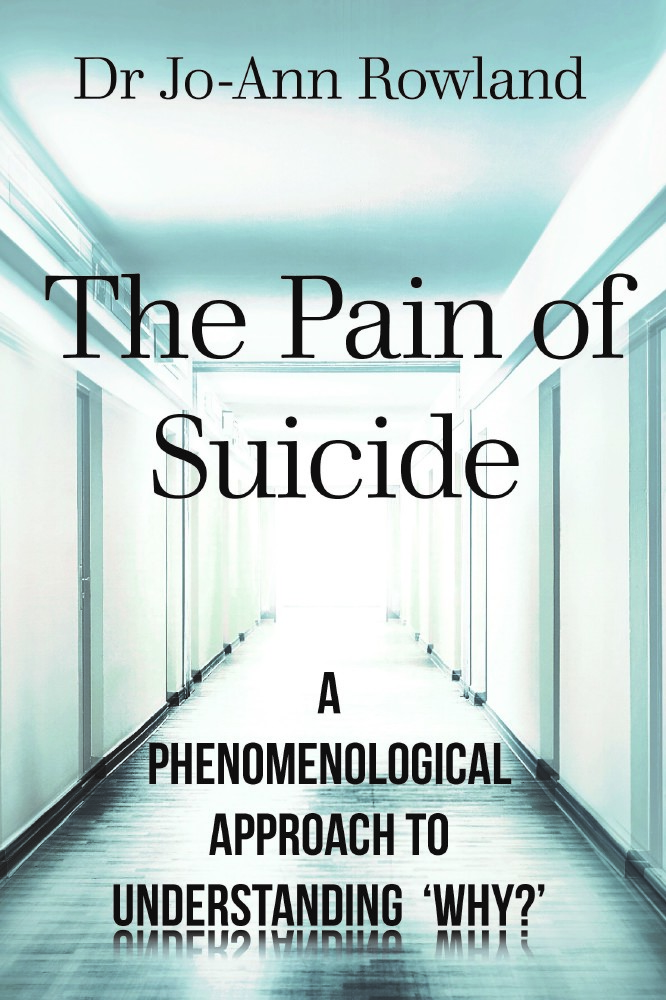Suicide is in the news all too often. Increasingly people of all ages are taking their lives. To mark Mental Health Awareness Week experienced counsellor and author Dr Jo-Ann Rowland, shares her insights and advice.

Dr Jo-Ann Rowland
Suicide is an emerging yet preventable global health issue. It is a tragic event and most of us know, or at least have heard of, someone who has committed suicide. Yet suicide is not that sort of subject you will easily and readily broach at a dinner table.
Although more women attempt suicide, many more men - approximately four times more - will die from suicide than women.
Why is there such a phenomenon which clearly has a devastating impact on the emotions and lives of survivors – families, friends, and communities?
Causes
Suicide is, in reality, a failed cry for help by someone in a situation of hopelessness and psychological pain. The pain usually stems from the inability to cope with challenging life circumstances. One suicide survivor describes suicide as the transference of the pain from the one who has committed suicide to the survivors left behind. In trying to explain her feelings which led her to attempt suicide, one sixteen year old young lady stated, “Mentally, I’m like an eggshell, a broken one”. Living like a broken eggshell can be incomprehensible. So how do we recognize and ultimately help someone who is suicidal?
How do we recognize and help someone who may be suicidal?
A history of one or more previous suicide attempts is certainly a warning sign. The experience of a suicide attempt sensitizes the individual’s suicide-related thoughts and behaviours such that they later become more accessible and active to repeat the attempt. It becomes more likely that the attempter will try until the act is completed. Expert counselling from a trained therapist is needed to help eliminate the suicidal thoughts and to encourage more rational thinking and behaviours. Additionally, the Samaritans can also provide a listening ear to those struggling with suicidal thoughts and the organization CALMs provides counselling specifically for men.
Depression and certain psychiatric disorders are other indicators that something is not right with one’s mental health. Medication must be taken as prescribed (especially anti-depressants and other mental health medications). However, simply medicating the depression is not the answer. It is important to understand the reason underlying the depression. The reasons are individualistic and diverse. Getting someone to talk when in fact they would prefer to stay in bed, in a dark room with the bedcovers over their heads is often a feat. Nevertheless, it is worth the challenge. Depression after delivering a baby (Postpartum Depression) is well known and affects 10 to 15% of women. Maternal depression is a serious mental illness if not addressed. Women are twice as likely to develop depression, and have more severe symptoms than men. Hormonal imbalance can have a profound effect on a mother’s mood. 40% of women will experience their first episode of postpartum depression[1]. To reduce the risk of a suicide attempt, clinicians need to know, and to ask, the right questions when a ‘new’ mother seems to be struggling.
I believe that the most difficult persons to help are those who spontaneously attempt suicide. They act out in the heat of the moment and access the nearest lethal weapon. Many young people have succumbed to suicide in this way. It is often as a result of an attack on their self-image, self-esteem or self-confidence through situations where they feel they have totally lost face. One seventeen year old committed suicide because his father was disciplining him with harsh words.
Helping to prevent such suicides will require having safe surroundings, where guns, knives, poisons and other lethal substances are locked securely away. It also requires responsible use of social media, good parenting skills and general awareness of others. If at any stage in a conversation someone says they plan to commit suicide, it is important to take him/her seriously and if you cannot deal with it, find someone who can. With the increase in suicide attempts by young persons, schools must also be alert. I suggest a two-fold care programme where if not in place, they firstly, include educational modules on monitoring and maintaining good mental health and, secondly, having a system whereby any deviation from what is perceived as normal student behaviour can immediately be addressed with the student and/or his/her caregiver(s).
Substance abuse (from, for example, alcohol and drugs) is another risk factor for suicide. In some cases, substance abuse can be as a result of other forms of abuse, such as, child sexual abuse (CSA). Where CSA has occurred, there are higher rates of suicidal thoughts and suicide attempts. Where CSA has been executed by a family member, this is particularly tragic since the child has to see the perpetrator most likely on a regular basis. Children must be helped to speak out during counselling as soon as the CSA is discovered or in the case of an adult, as soon as flash backs start to occur. Social reactions to a woman’s disclosure of sexual assault, especially where there is negative, unsupportive acknowledgement can affect how a woman copes with the assault. There is therefore a need for training for understanding so as to provide better outcomes for the woman.
Discordant or conflictual family relationships can affect mental health, forcing someone to consider suicide. Intimate partner violence (IPV) and domestic abuse situations increase stress. The true amount of IPV is unknown, particularly where the abused is male. Support tends to be more available for women victims of domestic abuse than it is for men. However, as mentioned earlier CALMs provide help support specifically for men.
Where a suicide has taken place, suicide survivors themselves are at risk of suicide. They should attend grief counselling preferably group counselling sessions where they can discuss the issues they face with other survivors. Meeting with other survivors as well as working with a professional therapist can help to bring about understanding of the tragedy.
Finally, if someone you know is experiencing a crisis, as far as possible, stay with them as long as you are personally safe and/or until appropriate assistance is available. Call the emergency service when you believe it is required. There are various helpline numbers such as the Samaritans (116 123) and CALM’s helpline 0800 58 58 58 (for men). However, there is great benefit in being connected to a network system of positive support such as friends, family, and community care groups in which isolation can be avoided.

The Pain of Suicide: A Phenomenological Approach to Understanding ‘Why?’ by Dr Jo-Ann Rowland, published by Clink Street, £14.99 paperback £6.99 ebook, is out now.
[1] Wisner, K. L., et al, 2013, Onset timing, thoughts of self-harm, and diagnoses in postpartum women with screen-positive depression findings, JAMA Psychiatry, 70 (2013), pp. 490-498.

